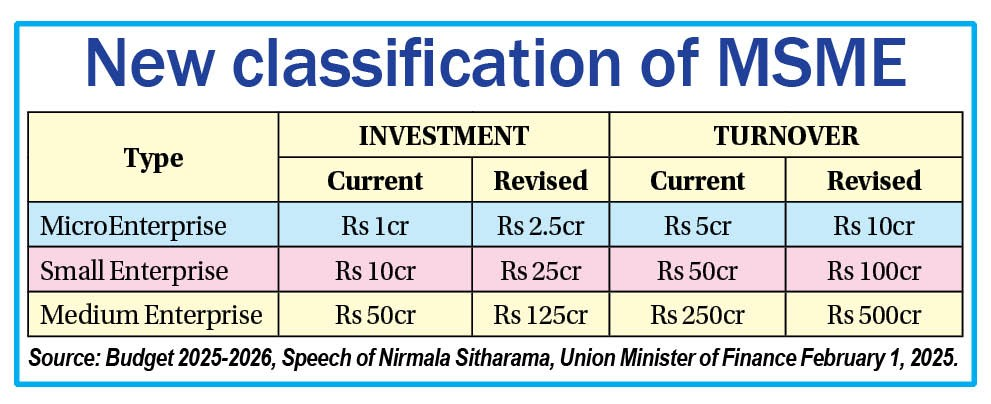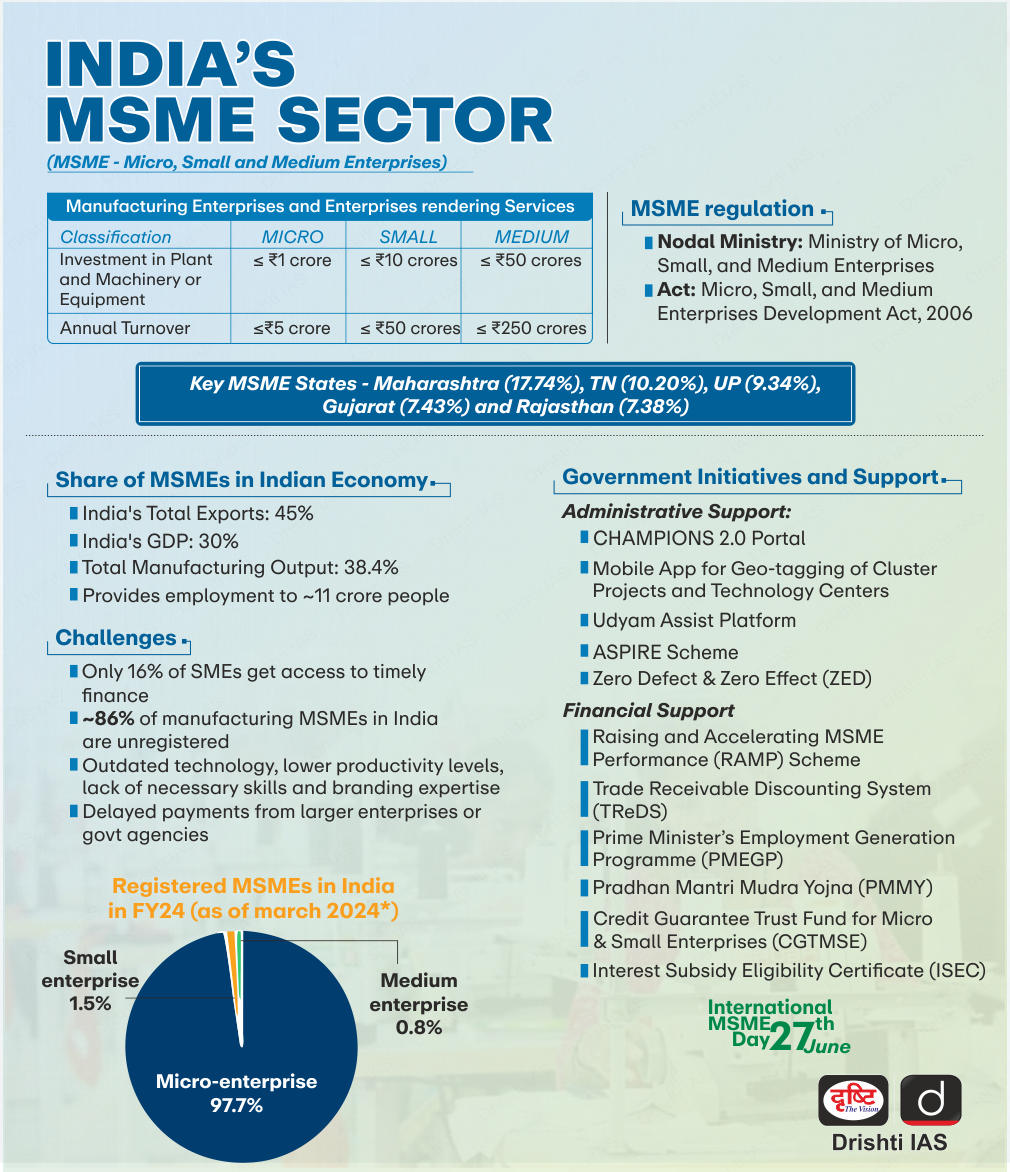NITI Aayog Report on MSMEs in India | 05 May 2025
For Prelims: NITI Aayog, Micro, Small, and Medium Enterprises, International MSME Day, Ministry of Micro, Small and Medium Enterprises, Manufacturing Sector, Mudra Yojana expansion, Udyam portal, Government e-Marketplace, Production-Linked Incentive, Digital MSME 2.0
For Mains: Role of MSMEs in Rural development, Role of MSMEs in India’s Economic Growth, Key Issues Hindering the Growth of MSME Sector.
Why in News?
NITI Aayog, in collaboration with the Institute for Competitiveness, released a comprehensive report identifying key challenges hindering MSME growth and proposing strategic reforms to enhance their competitiveness and economic impact.
What are MSMEs?
- About:
- Micro, Small, and Medium Enterprises (MSMEs) are businesses categorized based on their investment in plant & machinery or equipment and annual turnover.
- They play a crucial role in India's economic structure by promoting entrepreneurship, generating employment, and supporting industrialization in rural and semi-urban areas.
- Classification of MSMEs:
What Role do MSMEs Play in Driving India’s Economic Growth?
- Contribution to GDP and Employment: MSMEs contribute approximately 29.2% to India’s Gross Domestic Product (GDP), 36.2% to manufacturing output, and employing over 120 million people.
- For example, the textile industry, largely driven by MSMEs, employs millions in activities like spinning, weaving, and apparel manufacturing.
- Export Promotion: MSMEs contribute nearly 45% (FY 2021–22) of India’s total exports, strengthening India’s position in the global trade arena.
- The Indian handicraft sector, largely of small-scale enterprises, contributes significantly to export revenue, accounting for around 40% of global handmade carpet exports.
- Rural Industrialization: MSMEs promote rural industrialization and foster inclusive growth, aligning with Dr. APJ Abdul Kalam’s PURA (Providing Urban Amenities in Rural Areas) vision.
- For instance, the Khadi and Village Industries Commission (KVIC), consisting mainly of small-scale units, plays a critical role in providing employment and empowering local communities in rural areas, contributing to balanced regional development.
- Innovation and Entrepreneurship: MSME fosters innovation and entrepreneurship, with small businesses often quicker to adapt to changing market dynamics.
- India’s thriving startup ecosystem (the third-largest in the world) is predominantly driven by MSMEs, which have led to innovative solutions in sectors like e-commerce, fintech, and other emerging industries.
- Supporting Women Empowerment: MSMEs act as a catalyst for empowering women and marginalized communities by fostering inclusive entrepreneurship.
- According to the Udyam Registration Portal, over 20% of MSMEs are women-owned, highlighting the growing participation of women in the entrepreneurial ecosystem.
| Click Here to Read More: Significance of the MSME Sector in the Indian Economy |
What are the Key Challenges Faced by MSMEs in India?
As per the NITI Ayog’s Report on MSMEs:
- High Informatization: Over 90% of MSMEs in India remain informal, with only 9% of registered firms having transitioned from unregistered status.
- Despite efforts like the Udyam portal (95 lakh registrations vs 6.34 crore total MSMEs), high compliance costs and regulatory burdens deter many from formalising, limiting access to credit, schemes, and global value chains.
- Lack of Formal Credit Access:Despite improvements in credit access for MSMEs rising from 14% to 20% for micro/small and 4% to 9% for medium enterprises (2020–2024), a significant credit gap persists.
- Only 19% of credit demand was met by formal channels in FY21 with other challenges like lack of collateral, high NPAs, weak credit checks, and poor financial literacy, forcing many MSMEs to rely on informal credit at high interest rates (30–60%).
- Skill Gaps: From 2014-2022, skilled labor increased by 19.94% in small, 20% in medium, and 12.72% in large enterprises (World Bank).
- However, a significant skill mismatch exists, with a 3.9% decline in knowledge-intensive hiring.
- Product Diversification Challenges: MSMEs in India face barriers to product diversification due to limited market awareness, technical knowledge, and high costs for machinery and marketing.
- Despite 18% growth in customer base for diversified firms, challenges like high development costs, poor marketing, and limited access to finance hinder brand establishment and entry into international markets.
- Compliance Burden : Tax and other compliances remains a significant challenge for MSMEs in India.
- While GST has improved efficiency, it has also raised compliance costs and operational challenges for MSMEs.
- Inadequate Infrastructure & Outdated Technology: Despite India’s 40th rank in the 2023 Global Innovation Index, MSMEs face limited access to advanced technology, high costs, and unreliable infrastructure, restricting their scalability and integration into global value chains.
- Only 6% of MSMEs use e-commerce and just 45% have adopted AI, reflecting the sector’s slow pace of digital adoption.
- The "Missing Middle" Problem: Despite initiatives like ECLGS (Emergency Credit Line Guarantee Scheme) and Startup India, MSMEs in India struggle to access and fully utilize government schemes due to limited awareness and understanding.
- It reflects the underrepresentation of medium-sized enterprises, with 97.92% of MSMEs classified as micro, 1.89% classified as small and only 0.01% as medium.
- This gap is caused by strict regulations, high compliance costs, limited finance access, and low productivity.
- It reflects the underrepresentation of medium-sized enterprises, with 97.92% of MSMEs classified as micro, 1.89% classified as small and only 0.01% as medium.
What are the Key Recommendations by NITI Aayog on MSMEs?
- Reforming MSME Credit Access: To bridge the credit gap in MSMEs, it is essential to reform the Credit Guarantee Fund Trust for Micro and Small Enterprises (CGTMSE) by enhancing oversight and reducing risk premiums.
- NBFCs, especially in remote areas, should be scaled up with SIDBI funding to improve their capacity and governance.
- At the state level, lowering eligibility barriers for capital and interest subsidies will further support MSMEs at various stages of their growth.
- Skilling and Workforce Alignment: Invest in STEM education to meet MSME manpower needs, particularly in rural areas.
- Align training programs with industry demands and reform vocational education to address the skills gap, focusing on financial literacy and operational skills.
- States should offer partial subsidies for training, with curricula updated regularly to ensure relevance.
- Driving Tech & AI Adoption: Enhance MSME supply chains with digital risk management and tailored insurance products.
- Promote Artificial Intelligence (AI) adoption through subsidies, grants, and awareness campaigns.
- Support technological upgrades in textiles and chemicals, and develop affordable MSME-specific infrastructure. Invest in Industry 4.0 technologies to address obsolescence.
- Upgrading Innovation Ecosystem: Strengthen Institute for Collaborations (IFCs) to foster research, innovation, and technology upgrades for MSMEs by expanding knowledge networks between universities, research institutes, private entities, and government bodies.
- Upgrading Common Facilitation Centres (CFCs) to IFC standards will boost productivity, innovation, and competitiveness in the MSME sector.
- BoostingMarket Access and Supply Chain Management: MSMEs should receive export incentives and digital platform support, similar to initiatives in Haryana, Bihar, Andhra Pradesh, and Tamil Nadu, including quality certifications and market research.
- Collaboration with design schools and investment in new technologies will enhance competitiveness in sectors like textiles.
- States should invest in supply chain infrastructure and local training. Additionally, promoting food processing MSMEs through trade fairs and export programs will improve market access.
- Improving Policy Monitoring & Engagement: Enhance MSME policy awareness and outreach at the state level. Regular surveys should assess policy performance and drive improvements.
- Engage effectively with MSME stakeholders, including Owner-Operated Enterprises (OAEs) (where the owner is directly involved in the day-to-day operations) and women-owned enterprises.
- Capture informal sector MSMEs in datasets to reduce informality and identify areas for improvement.
More About MSME Sector in IndiaClick Here to Read: Key Issues Associated with MSME Sector in India, Measures to Enhance the Effectiveness of MSME in India |
What are the Key Government Initiatives for MSMEs?
- Pradhan Mantri MUDRA Yojana
- Mutual Credit Guarantee Scheme for MSMEs
- Udyam Registration
- CHAMPIONS Portal
- MSME SAMADHAAN
- Government e-Marketplace (GeM), an online platform for MSMEs to participate in public procurement, expanding their market access.
Conclusion
MSMEs are crucial to India's economic growth but face challenges due to inadequate data. Leveraging existing data sources like PLFS and improving platforms like UDYAM will help formulate better policies, enhance MSME competitiveness, and support their integration into global value chains, driving sustainable economic development.
|
Drishti Mains Question Prioritising the development of the Micro, Small and Medium Enterprises (MSMEs) sector is critical to the future of the country. Critically analyse. |
UPSC Civil Services Examination, Previous Year Question:(PYQ)
Prelims:
Q.1 What is/are the recent policy initiative(s)of Government of India to promote the growth of the manufacturing sector? (2012)
- Setting up of National Investment and Manufacturing Zones
- Providing the benefit of ‘single window clearance’
- Establishing the Technology Acquisition and Development Fund
Select the correct answer using the codes given below:
(a) 1 only
(b) 2 and 3 only
(c) 1 and 3 only
(d) 1, 2 and 3
Ans: (d)
Q2. Which of the following can aid in furthering the Government’s objective of inclusive growth? (2011)
- Promoting Self-Help Groups
- Promoting Micro, Small and Medium Enterprises
- Implementing the Right to Education Act
Select the correct answer using the codes given below:
(a) 1 only
(b) 1 and 2 only
(c) 2 and 3 only
(d) 1, 2 and 3
Ans: (d)
Q3. Consider the following statements with reference to India : (2023)
- According to the Micro, Small and Medium Enterprises Development (MSMED) Act, 2006, the ‘medium enterprises’ are those with investments in plant and machinery between `15 crore and `25 crore.
- All bank loans to the Micro, Small and Medium Enterprises qualify under the priority sector.
Which of the statements given above is/are correct?
(a) 1 only
(b) 2 only
(c) Both 1 and 2
(d) Neither 1 nor 2
Ans: (b)
Mains:
Q.1 “Industrial growth rate has lagged behind in the overall growth of Gross-Domestic-Product(GDP) in the post-reform period” Give reasons. How far are the recent changes in Industrial Policy capable of increasing the industrial growth rate? (2017)
Q.2 Normally countries shift from agriculture to industry and then later to services, but India shifted directly from agriculture to services. What are the reasons for the huge growth of services vis-a-vis the industry in the country? Can India become a developed country without a strong industrial base? (2014)


